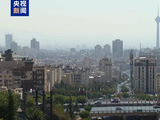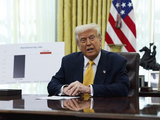Diplomatic Shifts; South Korea's Economic Challenges; U.S. Media Narratives; H-1B Visa Concerns; AI in Chinese Industry; China-U.S. Dialogue

International Recognition of Palestine: A Diplomatic Shift
Recent events show a significant diplomatic shift as several countries officially recognize Palestine as an independent state. Xinhua reports on the growing international calls for a two-state solution amid heightened military actions in the Gaza Strip by Israel. Countries like Portugal, the UK, Canada, and Australia have formally acknowledged Palestine, signaling a potential shift in global diplomatic stances.
These developments indicate that the recognition is partly driven by the ongoing conflict and humanitarian crisis in the region. Sina highlights Portugal's support for Palestine's right to self-determination and independence, emphasizing this move as a response to continuous clashes in Gaza and the lack of de-escalation.
Meanwhile, another Sina article underscores the severe impact of Israeli military actions, reporting 68 civilian deaths in recent attacks. This context of violence further propels international support for Palestine, with leaders like Abbas welcoming these recognitions and reiterating commitments to peace and reform.
In a coordinated effort, CCTV notes that Australia, Canada, and the UK have announced recognition as part of a broader international alignment to promote a two-state solution. This narrative aligns with the international community's strengthened calls for implementing such a solution, despite Israel's Prime Minister Netanyahu's firm stance against it.
It appears that the narrative across these publications reflects a concerted effort to highlight the humanitarian aspect of the conflict and the increasing international consensus on the need for a two-state resolution. The intention seems to be to pressure Israel into negotiations and to address the urgent humanitarian needs of the Palestinian people, as diplomatic recognition gains momentum.
South Korea's Economic Dilemma: Navigating U.S. Trade Demands
The recent discussions surrounding South Korea's economic negotiations with the United States reveal significant concerns about potential financial instability reminiscent of the 1997 Asian financial crisis. A report from United Daily News highlights South Korean President Lee Jae-myung's apprehensions about U.S. demands for a $3.5 billion cash investment in exchange for reduced tariffs on South Korean goods. Lee warns that without a currency exchange mechanism, meeting these demands could destabilize South Korea's economy, drawing parallels to the 1997 financial upheaval. The article underscores Lee's stance that the lack of commercial viability in the proposals has stalled formal agreements.
Similarly, World Journal echoes these concerns, emphasizing the potential economic peril if South Korea fully complies with U.S. requests. The publication also notes Lee's strategic efforts to stabilize the nation and promote South Korea's democratic resurgence on the global stage. It appears that both articles stress the importance of establishing a viable trade agreement that safeguards South Korea's economic interests.
Another report by United Daily News discusses the broader geopolitical implications, highlighting tensions with North Korea and the significance of maintaining strong alliances with the U.S. and Japan. The narrative suggests that the regional security dynamics are crucial in shaping South Korea's economic and political strategies.
Overall, these articles collectively portray a complex narrative where South Korea is navigating economic pressures and geopolitical tensions. The emphasis on historical financial crises serves as a cautionary tale to frame current negotiations, reflecting a broader concern for maintaining economic stability while managing international alliances.
Reflections on Charlie Kirk's Memorial: Diverging Narratives in U.S. Media
The recent memorial for Charlie Kirk, a prominent U.S. conservative figure, drew significant attention from media outlets, each presenting the event with its own narrative slant. CCTV reported on the memorial as a high-security event attended by U.S. President Donald Trump and Vice President JD Vance. The report highlighted Trump's remarks blaming the 'radical left' for Kirk's assassination, though no evidence was provided to support this claim. This coverage underscores a narrative aimed at emphasizing security concerns and political tensions.
In contrast, Liberty Times focused on the large turnout, estimating a crowd of 100,000, and the presence of influential figures like Elon Musk alongside Trump. The emphasis here was on the scale and fervor of the gathering, portraying it as a massive political rally intertwined with religious elements, as indicated by the presence of gospel music and the attire of attendees wearing Trump campaign merchandise.
While both reports agree on the memorial's grandeur and significant attendance, their narratives diverge on the implications and tone. CCTV's coverage leans towards a political critique, suggesting a narrative of division and blame, whereas Liberty Times presents a portrayal of unity and support within the conservative movement. This divergence illustrates how media outlets can shape public perception through selective emphasis and narrative framing.
H-1B Visa Fee Increase Sparks Panic Among Indian Professionals
Recent developments show a significant reaction to the U.S. administration's decision to impose a $10,000 fee on new H-1B visa applicants. According to Sina, this move has caused widespread panic among Indian nationals, who make up a substantial portion of H-1B visa holders. The Indian government has expressed concern over the potential impact on Indian families and has called for its embassies to assist affected citizens.
Meanwhile, Liberty Times highlights the confusion and distress experienced by Indian professionals, such as Rohan Mehta, who spent thousands on last-minute flights back to the U.S., fearing they would be unable to return if they missed the deadline. The article notes that the White House later clarified the fee applies only to new applicants, not current visa holders, but this clarification came too late for many.
These developments indicate a broader concern about the U.S.'s strategic handling of skilled immigration, especially as Indian IT companies, major beneficiaries of the H-1B program, are left to assess the implications of the fee increase. Both articles underscore the potential disruption to the tech industry and the individuals who contribute to it, with Sina noting the Indian government's hope that the U.S. will manage the situation sensibly to avoid unnecessary humanitarian consequences.
AI and Digital Transformation in Chinese Industry
Recent developments in China's industrial sector underscore the growing importance of artificial intelligence (AI) in driving digital transformation. According to a plan jointly issued by China's Ministry of Industry and Information Technology, Ministry of Commerce, and State Administration for Market Regulation, AI technologies are being harnessed to stabilize growth in light industries, focusing on applications like generative AI in product design and manufacturing. The plan, discussed in an article from Xinhua, emphasizes the integration of AI to enhance consumer and production cycles, aiming for personalized customization and quick response systems in sectors such as home appliances and sports equipment. The strategy further supports digital transformation by setting targets for 2027, promoting smart manufacturing, and facilitating cross-border e-commerce to optimize international trade.
Simultaneously, another piece from Xinhua highlights the challenges and opportunities AI presents in enterprise digitalization. As the AI industry transitions from a technology-driven to a value-driven approach, the emphasis shifts toward embedding AI into business value chains to achieve efficiency and risk management improvements. The article stresses that AI's real value lies in its ability to redefine industries, moving beyond mere technological upgrades to becoming a core driver of business strategy. This transformation is essential for enterprises aiming to capitalize on AI's potential in the next decade.
Both articles from Xinhua reflect a cohesive narrative promoting AI as a cornerstone of China's industrial strategy. They suggest a governmental push towards leveraging AI for economic growth and competitiveness, portraying AI not just as a tool but as a strategic asset in reshaping industries. This alignment indicates a broader policy objective to establish China as a leader in AI-driven innovation, setting the stage for a 'golden era' of digital and economic empowerment driven by AI advancements.
Diplomatic Engagements Between China and the U.S.: A Multifaceted Dialogue
Recent events show a significant diplomatic engagement between China and the U.S. as Chinese Premier Li Qiang met with a delegation of U.S. Congress members led by Smith in Beijing. According to the Foreign Ministry of China, Li emphasized the importance of stable and healthy China-U.S. relations, aligning with mutual interests and global expectations. He highlighted that ongoing communication between President Xi Jinping and President Trump underscores a strategic direction for bilateral relations, advocating for mutual respect and cooperation.
It appears that the Chinese narrative, as presented by the Foreign Ministry, seeks to frame the relationship as one of partnership and mutual benefit, urging the U.S. to view China positively and promote exchanges. This narrative aligns with China's broader diplomatic strategy of portraying itself as a cooperative global player, aiming to foster a constructive relationship with the U.S. amidst complex geopolitical tensions.



